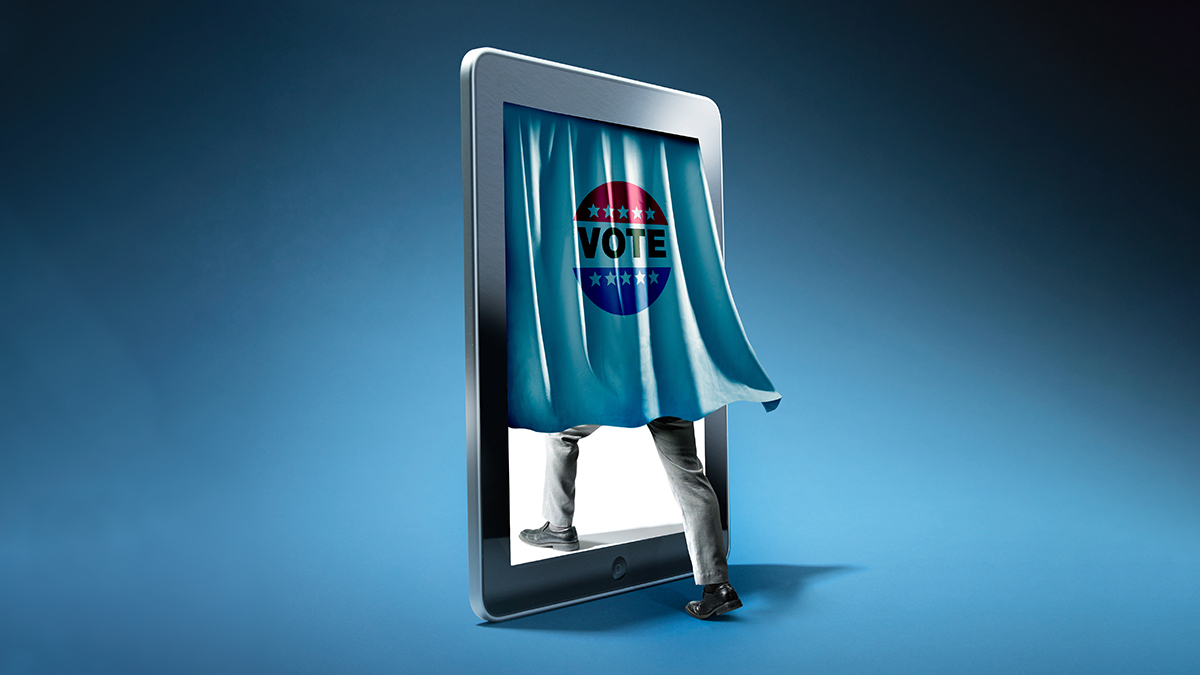Vote-by-Mail
Campaign Matrix clearly understands the nuances and issues surrounding vote-by-mail. That experience was derived from assisting clients over the past two (2) decades in the development and execution of effective digital advertising campaigns.
Vote-by-mail Introduction
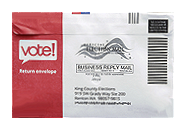 Vote-by-mail goes by many different names depending on where you live. These include, but are not limited to, Absentee, Early Voting, Mail-in, and others. Nevertheless, they all have one thing in common - constituents DO NOT have to stand in line on election day to cast their ballots.
Vote-by-mail goes by many different names depending on where you live. These include, but are not limited to, Absentee, Early Voting, Mail-in, and others. Nevertheless, they all have one thing in common - constituents DO NOT have to stand in line on election day to cast their ballots.The one thing that is self evident, more people will use "vote-by-mail" methods in the upcoming 2020 General election than ever before in American history.
On this page, we are sharing several lessons learned based on knowledge gleaned over the years. That experience can be put to work on your project in crafting a vote-by-mail digital advertising plan that is effective and budget friendly. Additionally, many of these lessons learned can also be applied in non-VBM environments.
Vote-by-mail Lessons Learned
Lessons Learned - Intelligent Micro Targeting
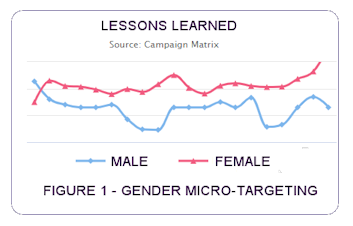 Intelligent micro targeting uses registered voter data and demographics to create audience subsets/segments. When used with a visual representation tool, like the Campaign Matrix dashboard, organizations can guage voter responses to their online digital advertising campaigns.
Intelligent micro targeting uses registered voter data and demographics to create audience subsets/segments. When used with a visual representation tool, like the Campaign Matrix dashboard, organizations can guage voter responses to their online digital advertising campaigns.Using your campaigns targeted voter list, micro targeting can provide valuable insight into constituent behavior when used properly.
In Figure 1, this campaign's voter list was segmented by gender. Segmentation possibilities are endless. For more information, visit the Dashboard page.
Lessons Learned - Creative Design
- The combination of digital media (Banners) and video ads are the most effective branding means.
- If you are planning to use digital media (Banners) animated GIFs are twice as effective (more clicks per thousand impressions) vs. static JPG images. (See examples below:


Lessons Learned - Impressions
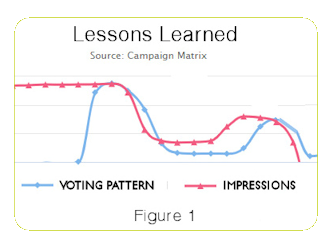 In the online digital advertising arena the term, impressions, means when an advertisement such as a banner ad or video renders on a user's screen. Impressions are also used when a streaming audio ad is heard.
In the online digital advertising arena the term, impressions, means when an advertisement such as a banner ad or video renders on a user's screen. Impressions are also used when a streaming audio ad is heard.Impressions are not action-based and are merely defined by a user (targeted voter) potentially seeing the advertisement.
Based on lessons learned, a vote-by-mail (VBM) ad campaign should be initiated at least two (2) weeks prior to ballots being mailed (see Figure 1). In almost every VBM scenario, a high propensity of voters will quickly complete and return their ballots (as shown with the Blue line). The Blue line at the end reflects procrastinators voting at the last minute.
Lessons Learned - Advertising Frequency
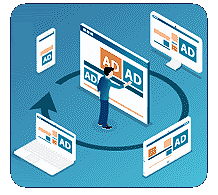 Frequency is an online advertising term referring to the number of times a targeted voter will see your advertisement over the life of the ad campaign.
Frequency is an online advertising term referring to the number of times a targeted voter will see your advertisement over the life of the ad campaign.We have seen many instances where a voter will cast their ballot based solely on name recognition. As such, building the brand is of paramount importance. That's where frequency becomes important.
Marketing studies have shown that frequency works best when a target voter sees your advertisement between ten (10) and twenty (20) times.
Special note: As cited above, frequency is more important than impressions.
Lessons Learned - Intelligent Advertising
 On average, banner ads can be delivered to the screens of targeted voters 20 times for the same cost as one direct mail piece.
On average, banner ads can be delivered to the screens of targeted voters 20 times for the same cost as one direct mail piece. Ask yourself, which would you prefer? A flyer that is seen once, OR a banner ad that is seen by your voter approx. 20 times? Factor in message personalization and the answer is really simple; in political messaging, frequency and personally connecting with your voter wins every time.
When you consider the number of flyers that will arrive after constituents have already voted (vote-by-mail, absentee, mail-in. etc.) that is tantamount to wasted opportunity and a poor use of campaign funds.
Lessons Learned - Managing Change
 Resistance to change is normal and expected; not surprisingly, campaigns have traditionally relied upon doing things that have worked in the past.
Resistance to change is normal and expected; not surprisingly, campaigns have traditionally relied upon doing things that have worked in the past.The current state of things has tremendous holding power, and the uncertainty of success and fear of the unknown can block change and create resistance.
Nevertheless, technological change in digital advertising is growing exponentially and it's having a profound impact on all organizations (campaigns).
In order to stay ahead of the competition, campaigns MUST embrace new technology or get left behind. Examples, Connected TV, Streaming Audio, and Mobile Device IDs.
VOTING AND COVID-19
 The COVID-19 situation as related to voting in the upcoming elections is unfolding quickly and there are changes almost daily. Campaign Matrix will do it's best to keep you abreast. Click on the buttons below for more information.
The COVID-19 situation as related to voting in the upcoming elections is unfolding quickly and there are changes almost daily. Campaign Matrix will do it's best to keep you abreast. Click on the buttons below for more information.
TIP - Always plan for VBM
Even if your State does not have a formal vote-by-mail program, most have a means whereby constituents can request a mail-in (absentee) ballot. We highly recommend that campaigns utilize the "Impressions" lessons learned.
TIP - Adjust In-Print Budgets
Where there is a significant mail-in voter-base, a majority of your political flyers will end up like the ones below. The picture (right) was taken at a U.S. Post Office two (2) weeks prior to election day.
Makes for a terrible ROI...
At that point in time, 45% of the total votes cast were already being counted.
Makes for a terrible ROI...
At that point in time, 45% of the total votes cast were already being counted.


